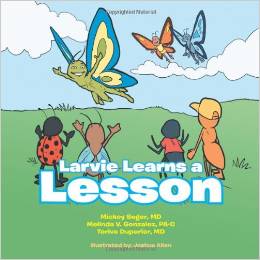 I was recently approached by a clinic called BMI of Texas, asking if I’d read and review a children’s book the doctors in the practice had written to help young patients and their families. The entire idea of a doctor’s office having written their own children’s book was, I have to say, somewhat intriguing to me. I’ve heard of many pediatricians and medical specialists recommending various books to their younger patients and their parents, but it’s not often that I hear about a medical practice actually taking matters into their own hands to write one themselves. I was intrigued enough to say yes, and “Larvie Learns a Lesson” arrived at my front door.
I was recently approached by a clinic called BMI of Texas, asking if I’d read and review a children’s book the doctors in the practice had written to help young patients and their families. The entire idea of a doctor’s office having written their own children’s book was, I have to say, somewhat intriguing to me. I’ve heard of many pediatricians and medical specialists recommending various books to their younger patients and their parents, but it’s not often that I hear about a medical practice actually taking matters into their own hands to write one themselves. I was intrigued enough to say yes, and “Larvie Learns a Lesson” arrived at my front door.
Before I can review the book, I think it’s important to give you a little bit of background on the practice itself and how the project came to be; in this case, context is everything. BMI of Texas is a medical weight-management practice. They specialize in bariatric surgery, but they have a strong focus on nutrition and health counseling – in other words, they’d prefer to help patients adopt healthy habits and help them manage their weight non-surgically, and try to provide resources to that end. In what I can only guess was a move geared towards preventing future surgical patients, the doctors in the group decided to write a children’s book that they could distribute, giving kids a simple framework for healthy habits.
“Larvie Learns a Lesson” is a short, colorful, direct read — and kid-approved by my five-year-old, which is certainly as important as anything else I might have to say about it! There’s no doubt, when you flip through its pages, that this is a children’s story written through the lens of doctors who see the troubling effects of obesity – at every age – on a daily basis. It’s the story of a young caterpillar whose parents feed him healthy fruits and vegetables at mealtimes to help him grow strong, so he’ll one day be able to spin his cocoon. However, as Larvie grows up, he starts to see lots of advertisements on television for foods that his parents haven’t given him. Assuming that the chips, crackers, cookies, sodas, and other junk items are good for him because he sees them advertised during his favorite shows, Larvie begins to eat these commercial foods, and soon grows fat and unhealthy. The book tells us that he’s short of breath and he can’t run and play as well as he used to. Larvie worries that he won’t be able to spin his cocoon.
At this point, Larvie’s parents take him to the doctor, who finds that Larvie is obese and has diabetes. The doctor tells Larvie that he needs to stop eating junk food and start exercising more. Larvie does, and soon he’s thin and fit again. He spins his cocoon and emerges from it a strong, beautiful butterfly.
Where “Larvie Learns a Lesson” succeeds is in its simplicity and focus on the way certain events impact Larvie himself – for example, Larvie’s worries begin when he feels that he can’t keep up with his friends at school while he’s playing. That’s a much more concrete way to explain the effects of obesity to kids than talking about blood sugar. It also gets a gold star from me for tackling the concept of direct junk food marketing to kids. As a basic educational tool that shows simple correlations between eating too much junk food and not being fully healthy, “Larvie” is fairly effective.
My feeling, though, is that “Larvie” probably belongs within its proper context: As a tool for children and families who are struggling with severe weight issues or are at a high risk for such issues, delivered with clinical or educational support. Outside of that context, I think it’s a story that may be right for some families, but not for all.
One thing I worry about: If kids who are struggling with their weight read “Larvie,” they may feel that it’s normal – expected, even – to drop a significant number of pounds by making healthier choices. In reality, that may not happen for every child, and certainly not as quickly as it does for Larvie. Would a child expecting a perfect, happy ending become discouraged or feel that there’s something wrong with them if they failed to realize their weight loss dreams? On the flip side of the issue, while the book gives a nod to diabetes at Larvie’s checkup, it seems to imply that obesity is the major danger in eating a diet heavy in junk food. That, to me, is a bit worrisome, as it plays right into the hands of a major challenge faced by parents and activists who lobby for healthier diets for children: “But my kid’s not fat!” seems to be a rallying cry for many adults, and “Larvie” does little to dispel the myth that thin = healthy and overweight by any measure = unhealthy, no matter what your habits.
Overall, though, I applaud the efforts of the BMI of Texas group. They saw a need in their immediate community, and they addressed it; whether it’s as nuanced as I think it could be or not, it’s clearly a timely and relevant tale for the population they’re working with, and has the sort of simple and straightforward messaging that appeals to very young children. What I’d like to see next is more doctors, and more people who work directly with kids and families, expanding on the initiative that “Larvie” has started to bring more balance, nuance, and greater educational value to the conversation for all families – obese or not.
If you’re curious to read “Larvie Learns a Lesson” for yourself, you can get a copy, either in paperback or Kindle format, through Amazon.
Thanks to the folks at BMI of Texas for providing me with a complimentary copy for review!

Hi showing your blog to my class